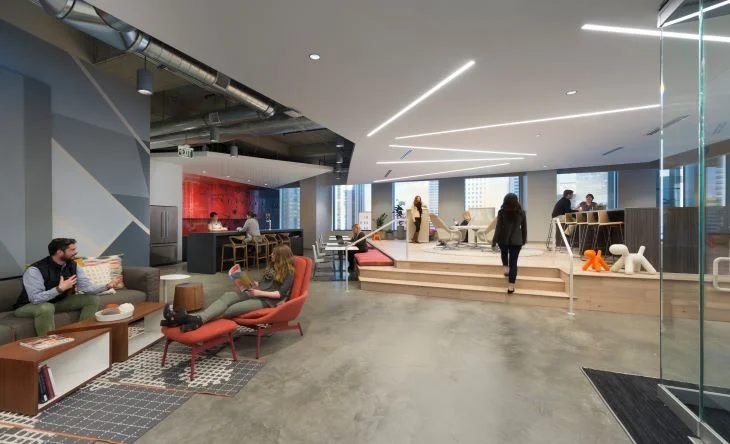How and where employees work continues to evolve, supported by integrated technology. @9 Amenity Center, Fifty South Sixth in Minneapolis by DLR Group. Photo by Brandon Stengel.
There was a time when full-time office work meant logging a 40-hour workweek between 8-5 in an office environment where everyone was assigned a personal workspace, which was often designated based on hierarchy; 5:00 p.m. and after was reserved for “personal time.”
Our work norm today looks much different. Modern office life is a broad composite of cultures and work styles, with people working in the office, out of the office, and around the clock. This ongoing shift in the makeup of our workforce has had dramatic implications for both employees and employers.
As we look to the future, business success will require a work environment and corporate atmosphere in support of today’s multi-faceted workforce. Understanding the characteristics of our evolving workforce and the elements stimulating this transformation will shed light on how the corporate workplace can be designed to support a blended talent pool. Organizations that get it right will focus on a talent-driven experience, inherent flexibility, fostering workplace culture, reliable technology, and striking an intentional balance between real estate cost and employee amenities.
A Snapshot of Today’s Workforce
In the past ten years, every industry has experienced a shift in workforce composition. Influenced by many factors, workers today fall under a variety of classifications, stretching far beyond the simplicity of the full-time and part-time labels of the past. Our workforce is now a blend of traditional and non-traditional roles commonly identified in the following categories:
Mobile/Telecommuter/Nomad: an individual who works outside the office, some or all the time.
Contingent/Freelance/Free-Agent: a non-employee, non-permanent worker, or consultant.
Free-address/Unassigned: individuals who work anywhere, either within or out of the office and who have no permanent desk.
Shared Address: employees, often mobile or on the road, who share desks, offices, or cubicles.
Resident/Assigned Address Worker: an individual who is primarily on-site with a dedicated workspace.
Coworking: a curated, touchdown community, typically free address, comprised of individuals, groups, or companies.
How Did We Get Here? Drivers Influencing the Shift in the Workforce
The workforce evolution in the United States has been enabled through several factors An understanding of these drivers helps us to predict patterns and ease challenges.
Real Estate Cost. Years ago, shrinking the real estate footprint to reduce overhead cost was a big instigator for alternative workplace strategies. While real estate cost is still a point of focus, today’s model balances “right-sized” personal space coupled with a variety of shared settings that offer choice in where and how work is performed.
Technology. Before high-speed internet, WiFi, reliable VPN, and portable technology, the practice of working anywhere, anytime was a challenge rather than an expectation. With processing speeds doubling every 18-24 months and devices reducing in size from boat anchors to pocket-sized computers, technology, more than any other factor, has enabled the non-traditional workforce of today.
The Pursuit of Life Balance. According to a study by The Workforce Institute at Kronos Inc., the United States tops the charts for overtime hours in comparison to other countries, with 49 percent of full-time workers clocking in more than 40 hours each week. Separating work life from personal life – or rather, learning to balance the integration of work life into personal life – has been a difficult task for most. There is a renewed emphasis on quality of life, spawning a movement toward flexibility in hours, superior technology, and creative culture.
Generational Shifts. Stereotyping people solely based on age is a dangerous game, but there are traits, attitudes, and aptitudes each generation possesses that have influenced many aspects of our working culture. Nowadays, it’s not uncommon to have a 50-year age span between workers within one company. While most of our current workforce is composed of the generations we refer to as Baby Boomers, Generation X, and Millennials, there is a great focus on the newcomers just entering the employment field: Generation Z. It’s anticipated that Millennials and Gen Z combined will make up nearly 70 percent of our workforce in the next four years.
In pursuit of purpose, balance, flexibility, and freedom, these two generations will continue to drive variety in work modes, variety in work settings, and flexibility in working relationships. But the younger generations aren’t the only age group redefining work culture. Baby Boomers have contributed greatly to our part-time workforce, whether they are working longer because they can, because they must, or because the workforce needs their talent and expertise, the Bureau of Labor Statistics shows a growing percentage of Baby Boomers working beyond Social Security age in full-time, part-time, and consultant capacities.Economy. The economy too has influenced worker habits and practice. An up economy brings confidence and extends a bit more rope for taking risks; a down economy causes some to shift from the independence of free agency to the security of employment and benefits. However, there are still longer-term work patterns that emerge despite the health of the economy. In other words, as the pendulum of the economy shifts from up to down or vice versa, worker habits will not necessarily revert to those of the past.
Embracing the Change: Tactics for Workplace Success with a Blended Workforce
The influx of this non-traditional workforce has presented both benefits and challenges to employees and employers. For employees the benefits are freedom, flexibility, and time savings; for employers, benefits can vary from access to an expanded workforce without necessarily expanding real estate, attraction and retention of talent who are looking for flexibility, and the ability to tap into a broader contingent talent pool. Challenges exist as well. For employees, there is risk in finding consistency in workflow, lack of benefits, and a lack of socialization and interaction. Similarly, for employers there is a loss of face-to-face communication, challenges with corporate culture, and a heightened need to cater to individual needs rather than a one-size-fits all approach.



